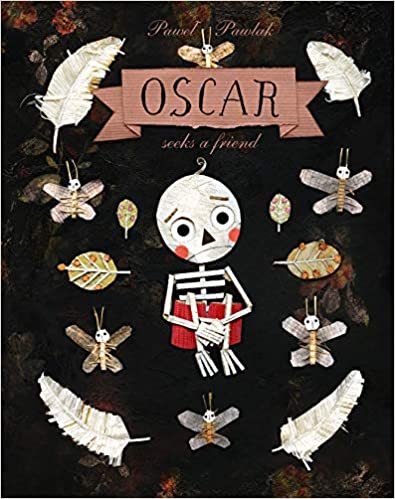
Price: £11.99
Publisher: Lantana Publishing
Genre: Picture Book
Age Range: Under 5s Pre-School/Nursery/Infant, 5-8 Infant/Junior, 8-10 Junior/Middle
Length: 40pp
Buy the Book
Oscar Seeks a Friend
Oscar the skeleton has lost a tooth. Maybe you think something like that wouldn’t matter – but as Oscar observes with disarming honesty, “it’s hard for a small, ugly skeleton to make friends” and when he spots a girl burying her tooth, he asks for it. Burying a tooth will make your dreams come true, or so we’re told, and the girl really wants a new friend. But when she sees Oscar’s gappy smile, she decides to give him the tooth as long as he helps her find a friend. Oscar agrees, so she shows him all the things she plans to share with her new friend: the scent of wet grass in a meadow, a mystery story about islands, the colours of a rainbow….
They have a lovely time together, and then it’s Oscar’s turn to act as host. At this point, what has been an enjoyable but somewhat unremarkable story shifts gear. Reaching across the central gutter of the book, Oscar takes the girl’s hand and guides her onto the left-hand page, and as he shares the delights of his skeleton world – skating in the park, an enormous library, butterflies sleeping on a flowering tree – we realise the significance of his dark backgrounds. Each world is beautiful, each is necessary. Both children have something important to give and receive in equal partnership.
The story ends on a fittingly optimistic note for such an upbeat exploration of ‘otherness’ – Oscar returns the borrowed tooth with the words “I think I’d found what I was looking for” – and we are left to assume the best for both of them. Even when differences seem profound, shared experiences create special bonds.
There’s lots to notice in Pawel Pawlak’s pictures, which demand attention and repay close looking. With their robust design and lively animation, Oscar and his skeletal companions evoke the Ahlbergs’ Funnybones or Mexican Day of the Dead images and children will warm to them. Pawlak used spatial collage to create his artwork, layering thin paper over cardboard shapes to produce a raised and textured effect, and there’s a theatrical feel to his layouts, particularly the wordless spreads, which reflects his set-design experience for puppet shows.
The artwork is really worth exploring and will inspire children’s own storymaking and other creative responses.



